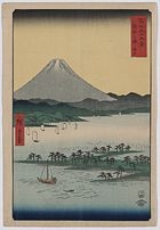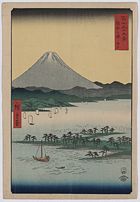
Miho no Matsubara
Encyclopedia

Shimizu-ku, Shizuoka
is one of three wards of the city of Shizuoka, in Shizuoka Prefecture, Japan, located in the eastern part of the city.-Geography:Shimizu is located on the coast of Suruga Bay of the Pacific Ocean and covers a wide area from a coastal plain to the hills...
area of Shizuoka
Shizuoka, Shizuoka
is the capital city of Shizuoka Prefecture, Japan, and the prefecture's second-largest city in terms of both population and area. It became one of Japan's 19 "designated cities" in 2005.-Geography:...
, Japan
Japan
Japan is an island nation in East Asia. Located in the Pacific Ocean, it lies to the east of the Sea of Japan, China, North Korea, South Korea and Russia, stretching from the Sea of Okhotsk in the north to the East China Sea and Taiwan in the south...
.
Overview
Miho no Matsubara is renowned as a seashore with beautiful green pine trees and white sands spanning over seven kilometers. It has a great scenic view of Mount FujiMount Fuji
is the highest mountain in Japan at . An active stratovolcano that last erupted in 1707–08, Mount Fuji lies about south-west of Tokyo, and can be seen from there on a clear day. Mount Fuji's exceptionally symmetrical cone is a well-known symbol of Japan and it is frequently depicted in art and...
and the Izu Peninsula
Izu Peninsula
The is a large mountainous peninsula with deeply indented coasts to the west of Tokyo on the Pacific coast of the island of Honshū, Japan. Formerly the eponymous Izu Province, Izu peninsula is now a part of Shizuoka Prefecture...
across Suruga Bay
Suruga Bay
Suruga Bay is a bay on the Pacific coast of Honshū in Shizuoka Prefecture, Japan. It is situated north of an imaginary line joining Omaezaki Point and Irōzaki Point at the tip of the Izu Peninsula and surrounded by Honshū to the southwest and west and the Izu Peninsula to the east.-Geology:Suruga...
. Due to its beauty, it is designated as one of along with its three pine groves (Sights of Shizuoka, http://www.shizuoka-cvb.or.jp/tour_guide/en/maps/miho.php.) Additionally, it has been selected as one of the top 100 white sand beaches and green pine groves of Japan. It has an old pine tree dating back 650 years. It is called “Hagoromo no Matsu
Hagoromo (play)
is among the most-performed Japanese Noh plays. It is an example of the traditional swan maiden motif.-Sources and history:The earliest recorded version of the legend dates to the eighth century. The play however apparently combines two legends, one concerning the origins of the Suruga Dance and...
” and is said to be where the angel wearing Hagoromo floated down. The Miho shrine
Shrine
A shrine is a holy or sacred place, which is dedicated to a specific deity, ancestor, hero, martyr, saint, daemon or similar figure of awe and respect, at which they are venerated or worshipped. Shrines often contain idols, relics, or other such objects associated with the figure being venerated....
nearby preserves a piece of her plumage.
Miho no Matsubara is known as the site of the legend of Hagoromo
Hagoromo (play)
is among the most-performed Japanese Noh plays. It is an example of the traditional swan maiden motif.-Sources and history:The earliest recorded version of the legend dates to the eighth century. The play however apparently combines two legends, one concerning the origins of the Suruga Dance and...
(the Feathered Robe), which is based on the traditional swan maiden motif
Motif (narrative)
In narrative, a motif is any recurring element that has symbolic significance in a story. Through its repetition, a motif can help produce other narrative aspects such as theme or mood....
. The story of Hagoromo concerns a celestial being flying over Miho no Matsubara who was overcome by the beauty of the white sands, green pines, and sparkling water. She removed her feathered robe and hung it over a pine tree before bathing in the beautiful waters. A fisherman named Hakuryo was walking along the beach and saw the angel. He took her robe and refused to return it until she performed a heavenly dance for him. As the angel could not return to heaven without her robe, she complied with Hakuryo's request. She danced in the spring twilight and returned to heaven in the light of the full moon leaving Hakuryo looking longingly after her.(See Whaley, Arthur, Hagoromo. The No Plays of Japan.New York: Alfred A. Knopf, 1922.) A statue of Hakuryo watching the dance is at the entrance to the park.
On the second Saturday and Sunday of October, the city of Shizuoka holds a Hagoromo Festival near the site of the old pine tree . The Noh play, Hagoromo, is performed by firelight (Takigi Noh)and also creative dances in honor of the French ballet dancer, Elene Giuglaris, are performed (Shizuoka City Tour Guide,http://www.shizuoka-cvb.or.jp/tour_guide/en/fes_evennts/). Giuglaris (1916-1951) loved the story of Hagoromo very much, but never saw the Noh performance nor did she visit Miho during her lifetime. Nontheless, her dying wish was, "Bury my hair near the Hagoromo pine tree at Mihonomatsubara beach" (Helene Giuglaris, http://members.jcom.home.ne.jp/fujinone/e_giuglaris.htm ). Above the Mihonomatsubara beach, overlooking the pine tree and the sea, is a monument to Giuglaris and a lock of her hair lies beneath it. The monument shows Giuglaris holding a Noh mask and below her figure is a poem written by her husband Marcel Giuglaris, who visited Miho four months after Elene's death with a lock of hair and her dance costume (Pine Grove at Miho,http://www4.tokai.or.jp/fuji-fusion/mihopine.html and Helene Giuglaris, http://members.jcom.home.ne.jp/fujinone/e_giuglaris.htm):
English translation by "Hiro" (http://www4.tokai.or.jp/fuji-fusion/mihopine.html)
The wind describes
The breaking waves of Miho
Far beyond Paris
My dearest dead wife longing for Hagoromo
The breaking waves take her life away to heaven
The wind blows and time goes through
I feel peaceful and quiet
Nowadays
Unfortunately, Miho no Matsubara no longer has white sands. The sands are now uniformly black, perhaps from the volcanic rock that first formed the peninsula. One local resident's story is that the Abe RiverAbe River
The is a river in Shizuoka Prefecture of central Japan. It is long and has a watershed of .The river rises from Akaishi Mountains which stretch over the border between Yamanashi and Shizuoka Prefectures, and flows into Suruga Bay in the Pacific Ocean)...
provided the white sand that made Miho such a scenic spot. During construction of the nearby shinkansen
Shinkansen
The , also known as THE BULLET TRAIN, is a network of high-speed railway lines in Japan operated by four Japan Railways Group companies. Starting with the Tōkaidō Shinkansen in 1964, the network has expanded to currently consist of of lines with maximum speeds of , of Mini-shinkansen with a...
line, too much of the Abe River's white sand was used. Over time, the sea swept away the layers of white sand and no new sand was available to replenish the sand carried out to sea.
Miho no Matsubara still has beautiful pine trees and a magnificent view of Mount Fuji on clear days, but the shining white sands that caused the angel in the legend to shed her robe and bathe in the sea at Miho can be seen only in the imagination.
See also
- Hagoromo (play)Hagoromo (play)is among the most-performed Japanese Noh plays. It is an example of the traditional swan maiden motif.-Sources and history:The earliest recorded version of the legend dates to the eighth century. The play however apparently combines two legends, one concerning the origins of the Suruga Dance and...

